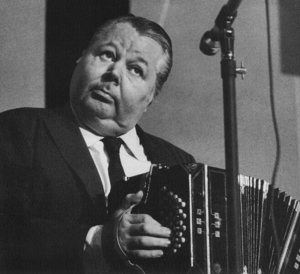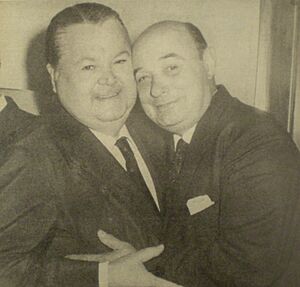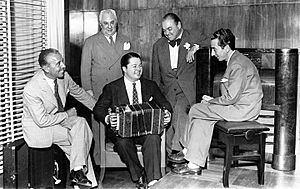Aníbal Troilo facts for kids
Quick facts for kids
Aníbal Carmelo Troilo
|
|
|---|---|

Troilo in 1971
|
|
| Background information | |
| Also known as | Pichuco |
| Born | 11 July 1914 Buenos Aires, Argentina |
| Died | May 18, 1975 (aged 60) Buenos Aires, Argentina |
| Genres | Tango |
| Occupation(s) | |
| Instruments | Bandoneon |
Aníbal Carmelo Troilo (born July 11, 1914 – died May 18, 1975) was a very famous Argentine tango musician. People often called him Pichuco.
Troilo was a master of the bandoneon, which is a special accordion-like instrument used in tango music. He was also a composer, an arranger (someone who organizes music), and a bandleader. His orchestra, called an orquesta típica, was one of the most popular for social dancers during the "golden age" of tango (from 1940 to 1955). Later, he changed his style to focus more on concert music.
Troilo's orchestra was especially known for its instrumental songs. But he also recorded with many famous singers like Roberto Goyeneche and Edmundo Rivero. A very famous bandoneon player named Astor Piazzolla even played in Troilo's orchestra from 1939 to 1944.
Contents
Aníbal Troilo's Life Story
Aníbal Troilo was born on July 11, 1914. His parents were Felisa Bagnoli and Aníbal Troilo. He grew up in the well-known neighborhood of Abasto in Buenos Aires.
His father gave him the nickname "Pichuco." This nickname came from an old word meaning "weepy" or "crybaby." Aníbal had one brother and one sister.
Early Musical Journey
When he was a child, Troilo loved listening to the bandoneon in the local bars. At just 10 years old, he convinced his mother to buy him his very first bandoneon. He kept this instrument and played it for his whole life.
Pichuco played his first public show in a bar when he was 11. By the age of 14, he had already started his own small music group, a quintet. He also studied at a very good high school in Argentina.
Joining Famous Orchestras
In December 1930, Troilo joined a famous music group called the Vardaro-Pugliese sextet. After this, he played in many other well-known orchestras. Some of these included groups led by Juan "Pacho" Maglio and Julio de Caro.
Leading His Own Orchestra
Aníbal Troilo led his own orchestra for many years. Its members changed over time, but they played almost constantly until he passed away in 1975.
From 1953 to the mid-1960s, Troilo also played in a duo with guitarist Roberto Grela. This duo later became the Troilo-Grela Quartet. In 1968, he formed his own group, the Aníbal Troilo Quartet. He even recorded two songs playing the bandoneon with Astor Piazzolla.
Troilo's close friend, the poet Homero Manzi, passed away in 1951. This made Troilo very sad for over a year. To remember his friend, he wrote a tango song called Responso.
Aníbal Troilo, often called the "Supreme Bandoneón of Buenos Aires," died on May 18, 1975. He passed away in a hospital in Buenos Aires. He is buried in a special part of the La Chacarita cemetery where many famous people rest.
What is Bandoneón Day?
In 2005, the government of Argentina made July 11 a special day. This day, which is Troilo's birthday, is now called National Bandoneón Day. It celebrates one of Argentina's most famous musicians and his instrument.
Aníbal Troilo's Compositions
Here is a list of some of the original tango songs Aníbal Troilo composed:
- Toda mi vida (1941)
- Con toda la voz que tengo (1941)
- Total pa’ qué sirvo (1941)
- Barrio de tango (1942)
- Pa’ que bailen los muchachos (1942)
- Acordándome de vos (1942)
- Valsecito amigo (1942)
- Garúa (1943)
- Media noche (1944)
- Naipe (1944)
- Garras (1945)
- María (1945)
- Tres y dos (1946)
- Con mi perro (1946)
- Mi tango triste (1946)
- Romance de barrio (1947)
- Sur (1948)
- Che, bandoneón (1950)
- La trampera (1951)
- Discepolín (1951)
- Responso (dedicated to Homero Manzi) (1951)
- A Pedro Maffia (with Roberto Grela) (1953)
- Vuelve la serenata (1953)
- Una canción (1953)
- Patio mío (1953)
- Milonga del mayoral (1953)
- La cantina (1954)
- A la guardia nueva (1955)
- La última curda (1956)
- Te llaman Malevo (1957)
- A Homero (1961)
- ¿Y a mí qué? (1962)
- Desencuentro (1962)
- Coplas (1962)
- Yo soy del treinta (1964)
- Milonguero triste (1965)
- Dale tango (1966)
- Nocturno a mi barrio (1969)
- Milonga de La Parda (1969)
- El último farol (1969)
- Fechoría (1970)
- Una canción (1971)
- La patraña (1972)
- Tu penúltimo tango (1975)
Aníbal Troilo's Music Albums
Here are some of the albums and recordings by Aníbal Troilo and his orchestra.
Aníbal Troilo y su Orquesta Típica
78 rpm Records
- Yuyo verde / Garras (1946)
- Yo soy el tango / Mano brava (1949)
- Tú / Y volveremos a querernos (1950)
LP Records
- Pichuco y sus cantores (1959)
- Con toda la voz que tengo (with Francisco Fiorentino) (1959)
- Cuando tallan los recuerdos (with Alberto Marino) (1959)
- Tristezas de la calle Corrientes (1959)
- Haunting! The Authentic Argentine Tango (1959)
- Tango recio (with Edmundo Rivero) (1963)
- Café de los Angelitos (with Alberto Marino) (1964)
- Aníbal Troilo – Floreal Ruiz (with Floreal Ruiz) (1964)
- El bulín de la calle Ayacucho (1964)
- Bien milonga (1965)
- Aníbal Troilo – Floreal Ruiz (with Floreal Ruiz) (1965)
- Pichuco sin palabras (1965)
- Troilo – Marino (vol. 3) (with Alberto Marino) (1965)
- Soy un porteño (1966)
- Aníbal Troilo y Roberto Grela (with Roberto Grela) (1966)
- La historia de Aníbal Troilo (vol. 1–3) (1966)
- Otra vez Pichuco 1966)
- Homenaje a Fiorentino (1966)
- Troilo for export (1966)
- Milongueando en el ’40 (1966)
- Tangos de hoy y de siempre (with Osvaldo Pugliese) (1966)
- Troilo – Rivero (with Edmundo Rivero) (1966)
- Lo mejor de Aníbal Troilo (1967)
- Aníbal Troilo for export (vol. 2) (1967)
- Pichuco sin palabras (vol. 2) (1967)
- Ni más ni menos (1968)
- Nuestro Buenos Aires (1968)
- Nocturno a mi barrio (1969)
- El Polaco y yo (with Roberto Goyeneche) (1969)
- Che Buenos Aires (1969)
- Las grandes estaciones de Aníbal Troilo (1969)
- For export (vol. 3) (1970)
- ¿Te acordás... Polaco? (1970)
- A mí me llaman Juan Tango (with Juan D'Arienzo) (1970)
- Tango en Caño 14 (with Atilio Stampone and Roberto Goyeneche) (1972)
- Para vos, Homero (1972)
- De vuelta a Salta (with Dino Saluzzi) (1973)
- Pichuco y sus cantores (1973)
- Raúl Berón y la orquesta de Aníbal Troilo (withRaúl Berón) (1973)
- Quejas de bandoneón (1974)
- Bandoneón tierra adentro (1975)
- Tiempo de Aníbal Troilo (1975)
- Ayer, hoy y siempre (1975)
- Recordando a Aníbal Troilo y su orquesta (1975)
- Latitud de Buenos Aires (1975)
- Bandoneón mayor de Buenos Aires (1975)
- Bandoneón mayor de Buenos Aires (vol. 2) (1975)
- Discepolín (1975)
- Troilo en stéreo (1975)
- El conventillo (1977)
- Recuerdos de bohemia (con el cantor Alberto Marino) (1978)
- Troilo en el ’40 (1979)
- Tango fran Argentina (1983)
CDs

- El inmortal Pichuco (1989)
- Del tiempo guapo (with Francisco Fiorentino) (1994)
- Cuando tallan los recuerdos (with Alberto Marino) (1994)
- Romance de barrio (with Floreal Ruiz) (1994)
- Sur (with Edmundo Rivero) (1994)
- Medianoche (with Jorge Casal and Raúl Berón) (1994)
- Quejas de bandoneón (1994)
- 40 grandes éxitos (1999)
Dúo Troilo-Grela
LP
- Esto es tango! (1963)
Aníbal Troilo's Movies
Aníbal Troilo also appeared in several movies:
- The Tango Returns to Paris (1948)
- Mi noche triste (1952)
- Vida nocturna (1955)
- Prisioneros de una noche (1960)
- Buenas noches, Buenos Aires (1964)
- Somos los mejores (1968)
- Tango Argentino (1969)
- Ésta es mi Argentina (1974)
- El canto cuenta su historia (1976)
See also
 In Spanish: Aníbal Troilo para niños
In Spanish: Aníbal Troilo para niños


